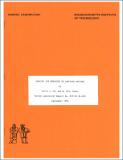Buoyant jet behavior in confined regions
Author(s)
Fry, David J.; Adams, E. Eric
DownloadEL_TR_1981_050.pdf (13.91Mb)
Alternative title
Jet diffusion in confined regions.
Other Contributors
United States. Dept. of Energy. Division of Central Solar Technology.
Metadata
Show full item recordAbstract
Previous confined jet studies have emphasized the behavior of non-buoyant jets inside ducts or near plane boundaries (Coanda effect). Buoyancy, however, is a major factor in the confined jet behavior experienced in many environmental fluid mechanics problems and, in particular, in the external fluid mechanics associated with an operating Ocean Thermal Energy Conversion (OTEC) plant. In many of these cases confinement and buoyancy offer opposing influences on jet trajectory and diffusion. An experimental set-up was designed, similar to some encountered in OTEC, but simple enough to facilitate accurate measurements and to allow the results to be interpreted through dimensional analysis. The particular experimental situation chosen was a submerged, negatively buoyant, horizontal, radial jet discharging into ambient water which was initially uniform in temperature and density. A near-surface intake was included in some experiments and not in others. Two distinct flow regimes were possible depending on the relative importance of buoyancy and confinement. The first flow regime (buoyancy-dominated) is termed a detached jet. The ambient region above the jet is an irrotational flow consisting entirely of original ambient fluid. The flow magnitude is determined by the entrainment requirements of the upper boundary of the jet and the intake flow, if any. The ambient region below the jet is made up of fluid pulled from the jet as it nears a vertical trajectory. The flow here is rotational and at a lower temperature than the original ambient fluid. The second flow regime (confinement-dominated) is termed an attached jet. Low pressures in the circulating region above the jet pull the jet to the surface. After impact the jet flow splits and no longer can be characterized as a jet. The portion of jet flow downstream from the impact point is negatively buoyant with respect to the original ambient fluid and therefore sinks - some returning as entrainment for the underside of the jet. In this case neither the top nor the bottom ambient region has the temperature of the original ambient water. Seventeen experiments yielded temperature and trajectory data on the radial jet in both of the flow regimes. Velocity data also were collected in the upper ambient region for the detached jet. Finally discharge conditions that caused transition from one flow regime to the other were determined. A hysterisis effect was noted as the conditions for "attaching" a detached jet were different from those needed to "detach" an attached jet. Dimensional analysis yielded a single dimensionless number that was fairly successful at predicting the transition points between regimes. However, three dimensionless numbers were apparently needed to completely characterize the experimental behavior. The dimensional analysis was also helpful in formulating an analytical jet model. An integral jet model (based on a spreading assumption) was successfully adapted to include effects of velocity and pressure fields in ambient regions. The model predicts jet trajectories, velocities, and temperatures, and transitions of experiments between flow regimes. The model can be applied to plane jets as well and buoyant and non-buoyant confined plane jet data from other studies were also compared with model predictions.
Date issued
1981Publisher
Cambridge, Mass. : Massachusetts Institute of Technology, Energy Laboratory, 1981
Series/Report no.
Energy Laboratory report (Massachusetts Institute of Technology. Energy Laboratory) no. MIT-EL 81-050.
Keywords
Ocean thermal power plants., Buoyant ascent (Hydrodynamics), Jets, Coanda effect.